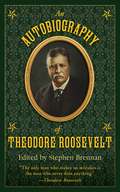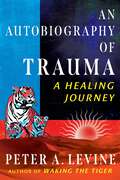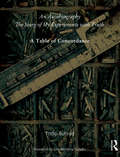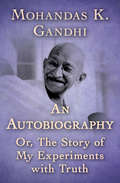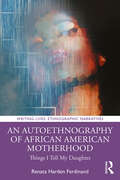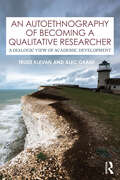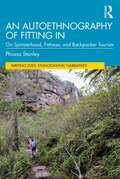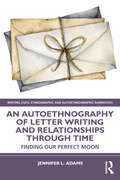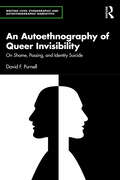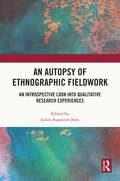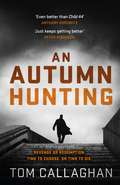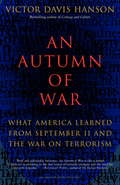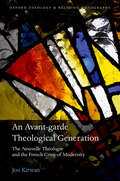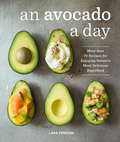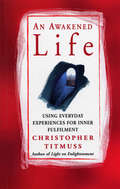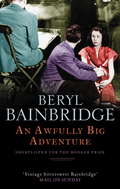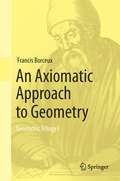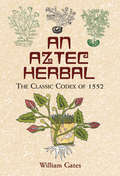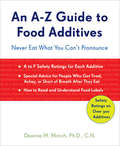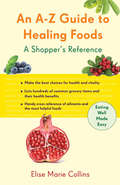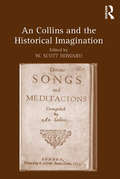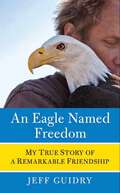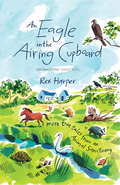- Table View
- List View
An Autobiography of Theodore Roosevelt
by Stephen BrennanBased in part on his own writings, this is the true story about one of America's most beloved leaders. From president of the board of New York City Police Commissioners, secretary of the Navy, founder of the Rough Riders during the war with Cuba, his time as the governor of New York, to vice president and eventually, after the assignation of President McKinley, becoming the twenty-sixth president of the United States, Theodore Roosevelt's role in the shaping of the United States is still felt today. Illustrated with drawing and photos, discover the rich history of this great man's life here.
An Autobiography of Trauma: A Healing Journey
by Peter A. Levine• Shares the author&’s personal journey to heal his severe childhood trauma as well as his breakthroughs on the path to create Somatic Experiencing• Explores how he came to view Einstein as his personal spirit guide and mentor, only to discover a profound real-life connection to him through his mother• Explains how the SE method is derived from the author&’s studies of animals in their natural environments, neurobiology, and 50 years of clinical observationsIn this intimate memoir, renowned developer of Somatic Experiencing, Peter A. Levine—the man who changed the way psychologists, doctors, and healers understand and treat the wounds of trauma and abuse—shares his personal journey to heal his own severe childhood trauma and offers profound insights into the evolution of his innovative healing method.Casting himself as a modern-day Chiron, the wounded healer of Greek mythology, Levine describes, in graphic detail, the violence of his childhood juxtaposed with specific happy memories and how being guided through Somatic Experiencing (SE) allowed him to illuminate and untangle his traumatic wounds. He also shares the mysterious and unexpected dreams and visions that have guided him through his life&’s work, including his dreamlike visitations from Albert Einstein, whom he views as his personal spirit guide and mentor.Explaining how he helped thousands of others before resolving his own trauma, he details how the SE method is derived from his studies of wild animals in their natural environments, neurobiology, and more than 50 years of clinical observations. Levine teaches us that anyone suffering from trauma has a valuable story to tell, and that by telling our stories, we can catalyze the return of hope, dignity, and wholeness.
An Autobiography or The Story of My Experiments with Truth
by M. K. GandhiGandhiji's autobiography, "The Story of My Experiments with Truth" is one of the most read titles of the world. The autobiography has been translated in more than 15 languages in India and is available in more than 50 different languages world wide. Navajivan Trust had published the title under Gandhiji's supervision first in 1927 and has sold more than 19,00,000 copies so far. The book has inspired more and more people to study Gandhiji's thoughts and deeds.
An Autobiography or The Story of My Experiments with Truth: A Table of Concordance
by Tridip SuhrudIn his translator's preface to the revised edition of Gandhiji's autobiography, Mahadev Desai stated:It has now undergone careful revision, and from the point of view of language, it has had the benefit of careful revision by a revered friend, who, among many other things, has the reputation of being an eminent English scholar. The identity of the 'revered friend' was not disclosed, nor were the extent and nature of changes recorded. This concordance table reconstructs the entire process of revision and provides a detailed analysis of the changes made by Sir V S Srinvasas Sastri.
An Autobiography or the Story of My Experiments with Truth
by Mahatma GandhiAlthough Gandhi presents his episodes chronologically, he leaves wide gaps, such as the entire satyagraha struggle in South Africa, for which he refers the reader to another of his books.
An Autobiography: Or, The Story of My Experiments with Truth (Mobi Classics Ser.)
by Mohandas K. GandhiThe remarkable life and inspiring beliefs of a legendary peacemaker and liberator of India—in his own words. Remember that all through history, there have been tyrants and murderers, and for a time, they seem invincible. But in the end, they always fall. Always. In the story of his life from early childhood through 1921, Mohandas K. Gandhi candidly reveals his young investigations into sin and seeking atonement; the philosophy, art, and literature that influenced his thoughts and ideas; and his first experiences with politics and protest, which would provide the foundation for his nonviolent struggle for justice, equality, and Indian independence from the British Empire. Gandhi&’s intention in setting down an account of his formative years was to clarify the spiritual principles by which he lived and to inspire individuals and movements in their quests for personal and political freedom. The timeless lessons to be derived from the autobiography of this dedicated seeker of truth and brilliant leader continue to resonate wherever freedom is challenged by tyranny. This ebook has been professionally proofread to ensure accuracy and readability on all devices.
An Autoethnography of African American Motherhood: Things I Tell My Daughter (Writing Lives: Ethnographic Narratives)
by Renata Harden FerdinandThis is the first full-length explicitly identified autoethnographic text on African American motherhood. It shows the lived experiences of Black motherhood, when mothering is shaped by race, gender, and class, and mothers must navigate not only their own, but also their children's positions in society. Ferdinand takes an intimate look at her mothering strategies spanning ten years (from 2007 to 2017), preparing her daughter to traverse a racist and sexist society. It is a multi-generational text that blends the author’s experience with that of her own mother, grandmother, and her daughter, to engage in a larger discussion of African American/Black mother/womanhood. It is grounded within Black Feminist Theory, which centers the experiences of Black women within the domains of intersecting oppressions. It is from a very personal position that Ferdinand provides a glimpse into the minutiae of mothering that reveal the everyday intricacies of Black women as mothers. It highlights specific strategies Black mothers use to combat discrimination and oppression, from teaching their children about the n-word to choosing positive representations of Black identity in movies, books, dolls, daycares, elementary schools, and even extra-curricular activities. It shows the impact that stereotypical manifestations of Black femininity have on Black women’s experience of motherhood, and how this affects Black women and girls' understanding of themselves, especially their skin color, body shape, and hair texture. As an interdisciplinary text, this book will be reading for academics and students in a broad range of fields, including Education, African American Studies, Communication Studies, Women Studies, Psychology and Health Studies. It is also a handbook of lived experience for Black mothers, grandmothers, and daughters, and for all mothers, grandmothers, and daughters irrespective of color.
An Autoethnography of Becoming A Qualitative Researcher: A Dialogic View of Academic Development
by Alec Grant Trude KlevanAn Autoethnography of Becoming a Qualitative Researcher chronicles Trude Klevan's personal experiences of her doctoral journey, with Alec Grant as an external academic resource and friend, and her subsequent entry into the neoliberal higher education environment. It gives a personal and intimate view of what it's like to become an academic. This book is constructed as an extended dialogue which frequently utilizes email exchanges as data. Firmly grounded in the epistemic resource of friendship, it tells the story of the authors’ symbiotic academic growth around their critical understanding and knowledge of qualitative inquiry and the purposes of such knowledge. The tale told is of the unfolding of a close and mutually beneficial relationship, entangled within sometimes facilitative, sometimes problematic, environmental contexts. It uses these experiences to describe, explore, and critically interrogate some underlying themes of the philosophies, politics, and practices of qualitative inquiry, and of higher education. Disrupting conventional academic norms through their work, friendship, and correspondence, Trude and Alec offer a critical and epistemological view of what it's like to become a qualitative researcher, and how we can do things differently in higher education. This book is suitable for all researchers and students, their supervisors, mentors, and teachers, and academics of qualitative research and autoethnography, and those interested in critiques of higher education.
An Autoethnography of Fitting In: On Spinsterhood, Fatness, and Backpacker Tourism (Writing Lives: Ethnographic Narratives)
by Phiona StanleyAn Autoethnography of Fitting In: On Spinsterhood, Fatness, and Backpacker Tourism is a feminist narrative about the social rules of obedience and acquiescence to the norm – embodiment, heteronormativity, partnering – and about fitting in, or not, with those narratives. Phiona Stanley explores a period through her twenties and thirties, living and travelling alone, foreign to herself and the countries of her travel in all regards: white, cisgender, sometimes thin, sometimes fat, sometimes partnered. This fascinating volume uses these lived experiences, depicted through first-person narrative storytelling, as a prism through which to understand the subtle, social rules of gendered normative expectations. It draws on contemporary journals, letters, and photos, and features process-oriented sections that focus on the methodological possibilities these offer, and on questions of verisimilitude and subjectivity. Set in the context of transnational work in Qatar, China, and elsewhere, and "road status" as negotiated and performed among long-term backpacker tourists, this book serves as an exemplar of how autoethnography can illuminate socio-cultural normativities and their effects – which are rarely explicit, but which nevertheless have great potential to harm – while problematizing and rethinking the meanings and semantic boundaries of weight, queerness, and (hetero)normativity. Framed through reflexive autoethnography, with a strong focus on ethics and feminist theories, this book will appeal to students and researchers in autoethnography, qualitative methods, and gender and women's studies.
An Autoethnography of Letter Writing and Relationships Through Time: Finding our Perfect Moon (Writing Lives: Ethnographic and Autoethnographic Narratives)
by Jennifer L. AdamsAn Autoethnography of Letter Writing and Relationships Through Time: Finding Our Perfect Moon is about love letters, stories, and the ability of words to bring people together across time and physical space. Weaving together edited and annotated letters between a young couple in the 1930s with interludes of autoethnographic reflection, the book relates the author’s experiences as she has negotiated this project over 20 years. Reading the letters is a sepia-toned window into the very private world of two young, well-educated Jewish-American people who lived their lives against the backdrop of the Jazz Age, the Great Depression, and Prohibition. The author uses reflective autoethnographic interludes to tell the story of finding the letters and to explore the significance of letters as a communicative genre. Adams considers the ethical implications of being a researcher eavesdropping on private moments in others' lives, and she explores the function of dialogue in the development of the romantic relationship that unfolds in the letters and between the letters and her. The author also advocates for the everyday relational communication practices that collectively comprise life's most important experiences. Students and researchers interested in letter-writing, autoethnography, and relationship development will find relevance in this book. It will also be of value to those interested in letter collections, the ethical implications of intimate research on people from the past who cannot offer consent, the role of nostalgia in interpersonal communication, and anyone who thrills at a love story told from primary documents from the past.
An Autoethnography of Queer Invisibility: On Shame, Passing, and Identity Suicide (Writing Lives: Ethnographic Narratives)
by David PurnellThis book recounts a personal journey of self-acceptance, focusing on the author's creation and reliance of a persona (Paul D. Drevlin) as a defense mechanism against societal and familial pressures.Beginning with a childhood marked by traumatic events, the author begins his desire of invisibility, later adopting the persona of Drevlin to navigate societal expectations and challenges, including his struggles with identity, sexuality, and religious conservatism. This book explores how the persona initially provided protection, safety, and acceptance to eventual self-realization that the persona was more a prisoner than a protector.The aim of this book is to open discussion regarding the shifts in acceptance experienced by the LGBTQ+ community over the years. It underscores the importance of family (whether that be birth family or family of choice) and peer support, community acceptance, and the changing dynamics of LGBTQ+ landscapes. The book also aims to stress the significance of fostering an inclusive society and respecting the diverse identities of individuals, advocating for understanding, empathy, and collective efforts toward equality and acceptance.Suitable for students studying LGBTQ+ studies, gender studies, sociology, psychology, social work, and creative writing, this book will also appeal to non-academic readers who may find the cultural and family themes significant to their own lives.
An Autopsy of Ethnographic Fieldwork: An Introspective Look into Qualitative Research Experiences
by Louis Augustin-JeanThis edited volume presents an international collection of fieldwork experiences from every stage of the research process with a view to normalising the process of adaptation, modification, and even failure during fieldwork when circumstances interrupt the expected outcomes.This book aims to address a gap often found in methodology books by including nine full autopsy-like reflection of fieldwork experiences, selected based on researchers’ disciplines and fields, the diversity of geographical locations and their differing themes. Its chapters record a swath of experience, from choosing the research themes and hypotheses through to academic presentations and publications, shedding light on an area academic research that is often overlooked.Documenting experience from anthropologists and sociologists to political scientists and economists, the diversity of the book’s approach and its multidisciplinary focus will interest researchers, scholars, and postgraduate students from a range of subdisciplines and levels of fieldwork experience.
An Autumn Hunting
by Tom Callaghan'Even better than Child 44. Akyl Borubaev is a terrific creation' Anthony Horowitz'Just keeps getting better . . . buy the whole series right away' Peter Robinson, No.1 bestselling author of Sleeping in the GroundNo sooner has Akyl Borubaev been reinstated as an Inspector in the Bishkek Murder Squad than he's suspended for alleged serious crimes against the state. After an attempted assassination of a prominent minister goes spectacularly wrong, Akyl is a fugitive from his former colleagues and involved with one of Kyrgyzstan's most dangerous criminals. On the run, caught up in a illegal scheme that can only end badly, it's time for Akyl to take a stand for everything he believes in.
An Autumn of War: What America Learned from September 11 and the War on Terrorism
by Victor Davis HansonOn September 11, 2001, hours after the terrorist attacks on New York and Washington, the eminent military historian Victor Davis Hanson wrote an article in which he asserted that the United States, like it or not, was now at war and had the moral right to respond with force. An Autumn of War, which opens with that first essay, will stimulate readers across the political spectrum to think more deeply about the attacks, the war, and their lessons for all of us.
An Avant-garde Theological Generation
by Jon KirwanAn Avant-garde Theological Generation examines the Fourvière Jesuits and Le Saulchoir Dominicans, theologians and philosophers who comprised the influential reform movement the nouvelle théologie. Led by Henri de Lubac, Jean Daniélou, Yves Congar, and Marie-Dominique Chenu, the movement flourished from the 1930s until its suppression in 1950. It aims to remedy certain historical deficiencies by constructing a history both sensitive to the wider intellectual, political, economic, and cultural milieu of the French interwar crisis, and that establishes continuity with the Modernist crisis and the First World War. Chapter One examines the modern French avant-garde generations that have shaped intellectual and political thought in France, providing context for a historical narrative of the nouvelle théologie. Chapters Two and Three examine the influential older generations that flourished from 1893 to 1914, such as the Dreyfus generation, the generation of Catholic Modernists, and two generations of older Jesuits and Dominicans, which were instrumental in the Fourvière Jesuits' development. Chapter Four explores the influence of the First World War and the years of the 1920s, during which the Jesuits and Dominicans were in religious and intellectual formation, relying heavily on unpublished letters and documents from the Jesuits archives in Paris (Vanves). Chapter Five analyses the crises of the interwar period and the emergence of the wider generation of 1930--to which the nouveaux théologiens belonged--and its intellectual thirst for revolution. Chapter Six examines the emergence of the ^ ressourcement thinkers during the tumultuous years of the 1930s. The decade of the 1940s, explored in Chapter Seven, saw the rise to prominence of the members of the generation of 1930, who, thanks to their participation in the resistance, emerged from the Second World War, with significant influence on the postwar French intellectual milieu. Finally, the monograph concludes in Chapter Eight with an examination of the triumph of French Left Catholicism and the nouvelle théologie during the 1960s at the Second Vatican Council.
An Avocado a Day: More than 70 Recipes for Enjoying Nature's Most Delicious Superfood
by Lara FerroniGo beyond guacamole! Research shows that adding an avocado a day to your diet helps improve your overall health, and this cookbook will show you how to enjoy avocados in 70 delicious and different ways. Even most avocado lovers don't know what to do with them beyond adding a slice or two to a sandwich or mashing one into guacamole. Here are 70 simple and delicious tasty recipes for everything from breakfast to dessert, including Avocado Green Curry Noodles, Tequila, Citrus and Ginger Stuffed Avocados, Avocado Waffles, and Avocado Key Lime Pie. Lara Ferroni educates readers on the various kinds of avocados and how to pick them, store them, and even grow them! Home cooks will learn how to make use avocado butter, oil, and honey, and how to incorporate avocados into any every meal of the day.From the Hardcover edition.
An Awakened Life: Using Everyday Experiences for Inner Fulfilment
by Christopher TitmussIn an awakened life, our hearts are open, steady and purposeful. Most people today have a greater income, as well as more goods and labour - saving devices, than any other generation in history. Yet stress, discontent, personal and social problems abound. Drawing on the deepest discoveries of the Buddhist tradition, well-known retreat master, Christopher Titmuss, suggests we spend far too much time in superficial preoccupaions and not enough in looking deeply into things. He urges us to fearlessly transform the forces of desire and dissatisfaction that haunt our daily lives - and to awaken to the Immeasurable. Inspired by the 20th Century classic, Zend Mind, Beginner's mind, he gives practical advice on such subjects as: understanding our feelings , taking risks, becomming more detached and rediscovering our true selves. And he shows us how to have free, fulfilled and uninhibited lives amidst the frenzy of everyday activity.
An Awfully Big Adventure: An Awfully Big Adventure, The Birthday Boys, And Master Georgie
by Beryl BainbridgeIt is 1950 and the Liverpool reporatory theatre company is rehearsing its Christmas production of Peter Pan, a story of childhood innocence and loss. Stella has been taken on as assistant stage manager and quickly becomes obsessed with Meredith, the dissolute director. But it is only when the celebrated O’Hara arrives to take the lead, that a different drama unfolds. In it, he and Stella are bound together in a past that neither dares to interpret.
An Axiomatic Approach to Geometry: Geometric Trilogy I
by Francis BorceuxFocusing methodologically on those historical aspects that are relevant to supporting intuition in axiomatic approaches to geometry, the book develops systematic and modern approaches to the three core aspects of axiomatic geometry: Euclidean, non-Euclidean and projective. Historically, axiomatic geometry marks the origin of formalized mathematical activity. It is in this discipline that most historically famous problems can be found, the solutions of which have led to various presently very active domains of research, especially in algebra. The recognition of the coherence of two-by-two contradictory axiomatic systems for geometry (like one single parallel, no parallel at all, several parallels) has led to the emergence of mathematical theories based on an arbitrary system of axioms, an essential feature of contemporary mathematics. This is a fascinating book for all those who teach or study axiomatic geometry, and who are interested in the history of geometry or who want to see a complete proof of one of the famous problems encountered, but not solved, during their studies: circle squaring, duplication of the cube, trisection of the angle, construction of regular polygons, construction of models of non-Euclidean geometries, etc. It also provides hundreds of figures that support intuition. Through 35 centuries of the history of geometry, discover the birth and follow the evolution of those innovative ideas that allowed humankind to develop so many aspects of contemporary mathematics. Understand the various levels of rigor which successively established themselves through the centuries. Be amazed, as mathematicians of the 19th century were, when observing that both an axiom and its contradiction can be chosen as a valid basis for developing a mathematical theory. Pass through the door of this incredible world of axiomatic mathematical theories!
An Aztec Herbal: The Classic Codex of 1552 (Native American)
by William GatesOriginally written in the Aztec language, this 16th-century codex was the first herbal and medical text compiled in the New World. It contains ancient remedies for myriad ailments -- boils, hair loss, cataracts, insomnia hiccoughs, and gout, to name a few. Analytical Index to Plants. New Introduction. Over 180 black-and-white and 38 color illustrations.
An A–Z Guide to Food Additives: Never Eat What You Can't Pronounce
by Deanna M. MinichA reference for decoding what those mysterious ingredients are—and how they may affect you: “The definitive guide for the health-conscious shopper.” —Robert H. Lerman, MD, PhDHere’s a tongue twister: Say cochineal extract, diacetyl, tertiary butylhydroquinone, BHA, HFCS, and MSG. It's not just knowing how to pronounce what’s in your food that’s important, it's knowing what it does and how it can affect you. The average American consumes about 150 pounds of food additives per year. With so many processed foods on the supermarket shelves, it can be hard to navigate the waters to an additive-free diet.A-Z Guide to Food Additives helps you change the way you eat and shop—providing heart-healthy tips while helping you avoid undesirable food additives. Also, you’ll get the rundown on which additives do no harm and may even be nutritious. This “additive translator” lets you head down to your grocery store with a grocery list in one hand and your newfound knowledge in the other.A-Z Guide to Food Additives delivers:Essential nutrition adviceHints on what to look for when reading those unreadable ingredient labelsTips on buying fresh produce in order to avoid pesticidesInformation on ingredients that can contribute to headaches, bloating, breathing difficulties, and other problemsSafety ratings for 300 ingredientsReference charts for additives that may cause cancer or allergic reactions, or should be limited for sodium-sensitive people
An A–Z Guide to Healing Foods: A Shopper's Reference (Conari Wellness)
by Elise Marie CollinsFind foods that fill you with a sense of well-being—and benefit your body—with this alphabetical, cross-referenced guide: “Fantastic.” —Christiane Northrup, MD, #1 New York Times-bestselling author of Women’s Bodies, Women’s WisdomFilled with scientific information, natural remedies, and modern wisdom, this concise reference is for anyone confused by all the nutritional claims out there. How do you separate real benefits from marketing hype? What is a “superfood” anyway? Alternative health expert Elise Collins has compiled a compact yet comprehensive list of hundreds of healing foods, their vitamin and mineral content, and what they do to promote health, prevent disease, and decrease symptoms of illness.Arranged alphabetically and complete with a cross-reference for what's best to eat for specific ailments, this guidebook is designed to be as convenient as a shopping list. Included are preparation tips and recipes to make this the ultimate tool for joyful eating and radiant health.“Encyclopedic information on the nutritional, medical, and holistic benefits of foods.” —Dana Jacobi, author of 12 Best Foods Cookbook
An Collins and the Historical Imagination
by W. Scott HowardThe first edited collection of scholarly essays to focus exclusively on An Collins, this volume examines the significance of an important religious and political poet from seventeenth-century England. The book celebrates Collins’s writing within her own time and ours through a comprehensive assessment of her poetics, literary, religious and political contexts, critical reception, and scholarly tradition. An Collins and the Historical Imagination engages with the complete arc of research and interpretation concerning Collins’s poetry from 1653 to the present. The volume defines the center and circumference of Collins scholarship for twenty-first century readers. The book’s thematically linked chapters and appendices provide a multifaceted investigation of An Collins’s writing, religious and political milieu, and literary legacy within her time and ours.
An Eagle Named Freedom: My True Story of a Remarkable Friendship
by Jeff Guidry“A hauntingly beautiful story of rescue and rehabilitation….[A] gorgeous tale of redemption.”—Susan Richards, New York Times bestselling author of Chosen by a Horse“I could not put this book down.”—Stacey O'Brien, New York Times bestselling author of Wesley the OwlFrom the moment Jeff Guidry saw the emaciated baby eagle with broken wings, his life was changed. For weeks he and the staff at Sarvey Wildlife Care Center tended to the grievously injured bird. Miraculously, she recovered, and Jeff, a center volunteer, became her devoted caretaker.Though Freedom would never fly, she had Jeff as her wings. And after Jeff was diagnosed with stage 3 non-Hodgkin's lymphoma in 2000, Freedom returned his gift. Between sessions of debilitating chemotherapy, Jeff went back to Sarvey and began taking Freedom for walks that soothed his spirit and gave him the strength to fight. A tender tale of hope, love, trust, and life, this moving true story is an affirmation of the spiritual connection that humans and animals share.
An Eagle in the Airing Cupboard
by Rex HarperAN EAGLE IN THE AIRING CUPBOARD picks up where Rex Harpers first book, AN OTTER ON THE AGA, left off. It follows the fortunes of the Cornish RSPCA centre through one of its most testing twelve months. Once more it is a mixture of funny, touching and sometimes moving animal stories. And once more it features a cast of unforgettable characters, like Alfie and Blue, two hideously mistreated greyhounds that are rehabilitated at the farm, as well as the return of old favourites from Rex's first book, including his loyal dog Moss. Throughout, Rex evokes the sights, smells, sounds and spirit of the Cornish countryside in all its timeless beauty. He also encounters sickening cases of animal cruelty committed by humans unfit to care for any living thing. Funny, warm and evocative, it is a book that is, once more, set to melt and occasionally break the hearts of animal lovers everywhere.
